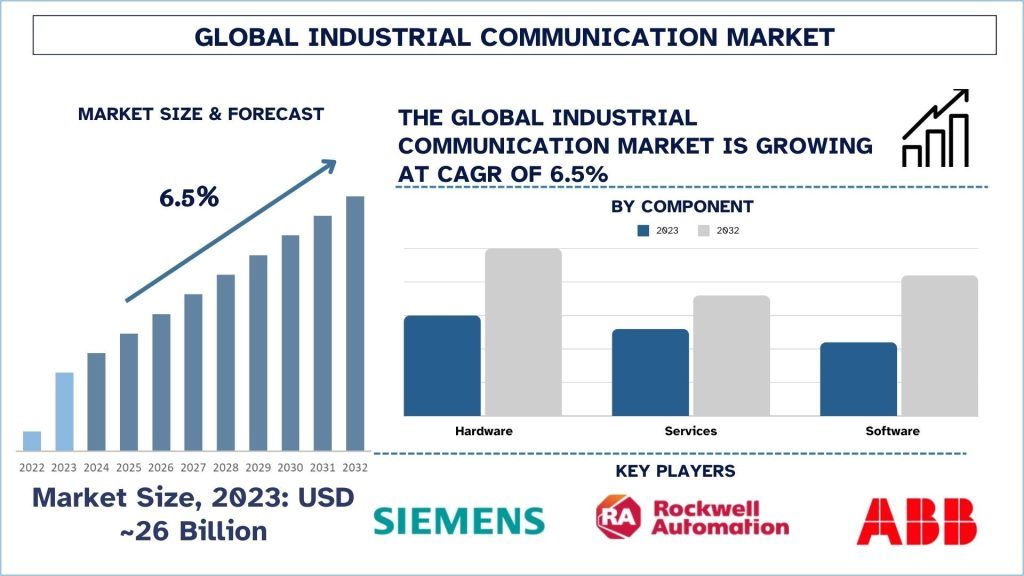- Accueil
- À propos de nous
- Industrie
- Services
- Lecture
- Contactez-nous
Marché de la communication industrielle : analyse actuelle et prévisions (2024-2032)
Accent sur les composants (matériel, services, logiciels), les protocoles de communication (Ethernet industriel, bus de terrain, sans fil, cloud, OPA/UA et autres) ; secteur d'activité (automobile et transports, aérospatiale et défense, alimentation et boissons, électricité et électronique, pétrole et gaz, chimie et produits pharmaceutiques, et autres) ; et région/pays
Taille et prévisions du marché de la communication industrielle
Le marché de la communication industrielle était évalué à environ 26 milliards de dollars américains en 2023 et devrait croître à un TCAC substantiel d'environ 6,5 % au cours de la période de prévision (2024-2032), en raison de l'adoption croissante des communications sans fil.
Analyse du marché de la communication industrielle
La communication industrielle peut être définie comme les procédures utilisées pour transmettre des données et des informations entre et/ou parmi différents systèmes industriels, machines ainsi que des dispositifs pour permettre la commande, l'automatisation, la surveillance et la gestion des procédures industrielles. Elle englobe l'utilisation de canaux de communication particuliers, d'équipements ou de canaux, et une inter-connectivité physique adaptée à un fonctionnement dans des conditions industrielles variées et sévères, sans compromettre le relais de données en temps réel et sécurisé. Quelques exemples de technologies de communication industrielle sont l'Ethernet industriel, le bus de terrain, le sans-fil industriel et des protocoles tels que PROFINET, EtherCAT et Modbus.
Les entreprises se concentrent sur l'introduction d'une combinaison de technologies de pointe qui incluent les réseaux 5G, le calcul en périphérie et les solutions IIoT dans l'expansion du marché de la communication industrielle. Par exemple, le 29 janvier 2024, Moxa Inc., un leader dans les communications et la mise en réseau industrielles, a officiellement annoncé le lancement d'une nouvelle famille d'ordinateurs industriels x86 (IPC) avec une fiabilité, une adaptabilité et une longévité exceptionnelles pour répondre aux demandes croissantes de connectivité des données et de traitement en temps réel de grands volumes de données de capteurs et de dispositifs en périphérie industrielle. De plus, les entreprises se tournent vers la sécurité du réseau, protégeant les réseaux industriels contre les cybermenaces et adoptant un protocole unique pour la communication afin de les rendre interopérables.
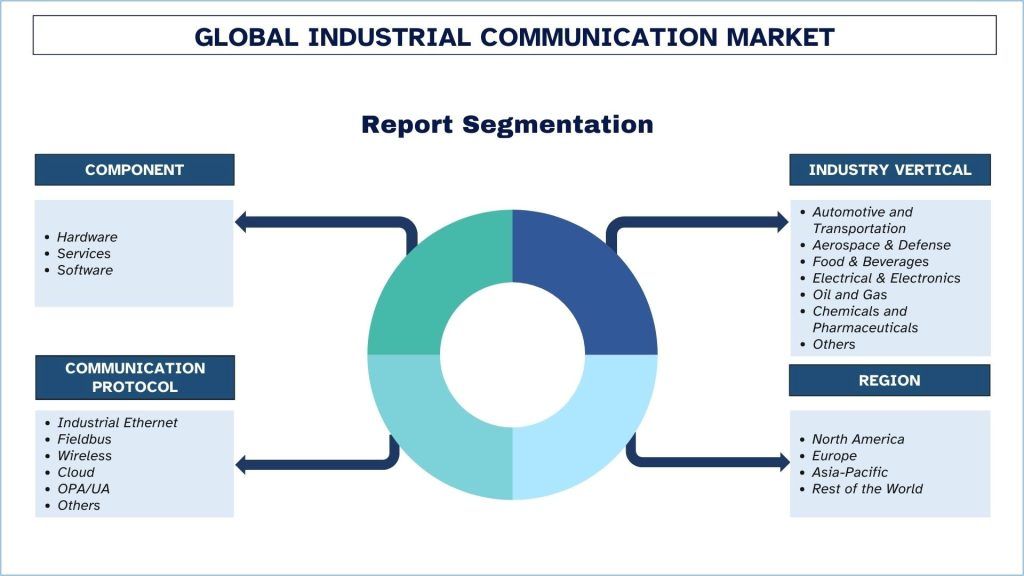
Tendances du marché de la communication industrielle
Cette section présente les principales tendances du marché qui influencent les différents segments du marché de la communication industrielle, telles qu'identifiées par nos experts en recherche.
L'Ethernet industriel transforme l'industrie de la communication industrielle
L'Ethernet industriel détenait une part importante du marché en 2023. Il offre une communication de données à haut débit, fiable et évolutive pour les systèmes d'automatisation et de contrôle industriels. De plus, il offre une bande passante plus large et, par conséquent, un échange de données en temps réel, ce qui est essentiel dans les industries manufacturières d'aujourd'hui où un transfert de données rapide et précis est nécessaire. Sa fiabilité et sa capacité à gérer des données importantes le rendent adapté à l'interconnexion des tendances modernes telles que les appareils IoT, les capteurs et les machines intelligentes, entre autres. Par exemple, le 1er juillet 2024, Moxa a lancé son portefeuille de commutateurs Ethernet à haut débit, la nouvelle série MRX de commutateurs Ethernet rackables de couche 3 qui prennent en charge 64 ports avec jusqu'à 16 ports de vitesse 10 GbE pour accélérer l'agrégation de données pour les applications industrielles, et aident les utilisateurs à construire une infrastructure réseau à haut débit pour réaliser la convergence IT/OT avec les commutateurs Ethernet sur rail DIN de couche 2 de la série EDS-4000/G4000 prenant en charge les options de liaison montante 2,5 GbE. En outre, l'acceptation mondiale des protocoles Ethernet industriels, notamment PROFINET, EtherNet/IP et Modbus TCP, permet l'intégration et la communication entre les différents appareils et systèmes, minimisant ainsi le gaspillage de temps en cas de panne du système ou de manque d'efficacité.
L'Amérique du Nord détient une part importante du marché en 2023.
L'accent mis par la région sur l'avancement des initiatives d'Industrie 4.0 et de fabrication intelligente a créé une forte demande de systèmes de communication améliorés qui facilitent le traitement des données en temps réel et l'automatisation. Par exemple, le 28 février 2024, GE Vernova a annoncé la sortie de Proficy for Sustainability Insights, une nouvelle solution logicielle conçue pour opérationnaliser les objectifs des fabricants en matière de durabilité, tout en aidant à maximiser la productivité et la rentabilité. En intégrant les données opérationnelles et de durabilité, un logiciel basé sur l'intelligence artificielle (IA) peut aider les entreprises industrielles à utiliser les ressources de manière plus efficace et efficiente dans une usine ou dans l'ensemble de l'entreprise, ainsi qu'à gérer les indicateurs climatiques requis pour la conformité réglementaire. En outre, les entreprises en Amérique du Nord intègrent l'Ethernet industriel, l'IIoT et la 5G pour stimuler la productivité, synchroniser l'installation d'équipements améliorés et exploiter la prise de décision axée sur les informations. De plus, l'importance croissante accordée à la sécurité de la région reflète également le besoin de meilleures solutions de communication pour atténuer les cybermenaces dans les réseaux industriels. Par conséquent, le fait de disposer d'acteurs majeurs clés et d'une base industrielle développée améliore également l'efficacité de l'application de technologies de communication avancées en Amérique du Nord, faisant de l'Amérique du Nord un moteur important pour la croissance du marché de la communication industrielle.
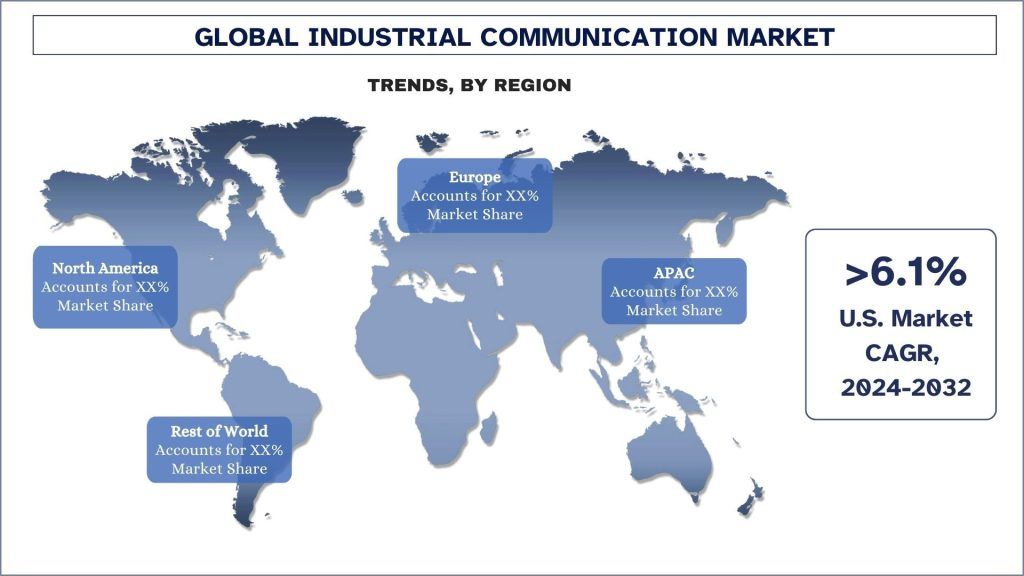
Aperçu de l'industrie de la communication industrielle
Le marché de la communication industrielle est concurrentiel, avec plusieurs acteurs mondiaux et internationaux. Les principaux acteurs adoptent différentes stratégies de croissance pour améliorer leur présence sur le marché, telles que des partenariats, des accords, des collaborations, de nouveaux lancements de produits, des expansions géographiques et des fusions et acquisitions. Certains des principaux acteurs opérant sur le marché sont Siemens, Rockwell Automation, ABB, Schneider Electric, la société GE Vernova, Cisco Systems, Inc., Phoenix Contact, MOXA, NXP Semiconductors et Advantech Co., Ltd.
Actualités du marché de la communication industrielle
Le 25 juillet 2024 – Cisco, un leader mondial de la mise en réseau et de la sécurité, et Rockwell Automation, la plus grande entreprise au monde dédiée à l'automatisation industrielle et à la transformation numérique, ont annoncé une collaboration pour propulser la transformation numérique du marché industriel dans la région Asie-Pacifique, Japon et Grande Chine. L'annonce a été faite lorsque les deux sociétés ont signé un protocole d'accord (MOU) à ce sujet.
Le 13 mars 2024 – Rockwell Automation, Inc., la plus grande entreprise au monde dédiée à l'automatisation industrielle et à la transformation numérique, a annoncé le lancement de sa gamme de produits CUBIC Modular Switchboard et Motor Control Center (MCC) dans la région Asie-Pacifique. CUBIC est spécialisé dans les systèmes d'enceintes modulaires conformes à la norme IEC-61439 pour la construction de panneaux électriques et d'alimentation.
Le 28 septembre 2023, Siemens a lancé une infrastructure privée développée en interne pour la norme de communication mobile 5G. La solution permet aux entreprises industrielles de construire leurs propres réseaux 5G locaux qui offriront un soutien optimal aux applications d'automatisation.
Le 30 mai 2023 – Moxa Inc. a annoncé qu'elle avait rejoint Avnu Alliance, le forum industriel qui intègre des capacités déterministes dans les réseaux ouverts basés sur des normes en tant que membre promoteur pour faire progresser l'interopérabilité de l'écosystème des réseaux sensibles au temps (TSN). L'adhésion de Moxa est très prometteuse et se concentre sur le travail sur une infrastructure réseau véritablement unifiée et performante qui permet à tous les types de trafic de coexister pour des exigences de communication en temps réel, de faible latence et de haute fiabilité dans diverses applications.
Couverture du rapport sur le marché de la communication industrielle
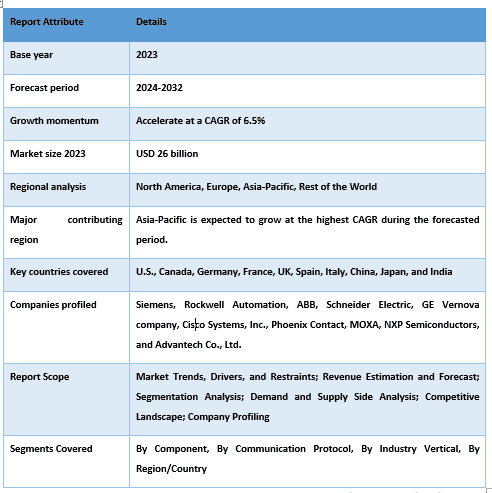
Raisons d'acheter ce rapport :
- L'étude comprend une analyse de dimensionnement et de prévision du marché validée par des experts clés authentifiés de l'industrie.
- Le rapport présente un aperçu rapide des performances globales de l'industrie en un coup d'œil.
- Le rapport couvre une analyse approfondie des principaux acteurs de l'industrie, en mettant l'accent sur les principaux éléments financiers de l'entreprise, les portefeuilles de produits, les stratégies d'expansion et les développements récents.
- Examen détaillé des moteurs, des contraintes, des principales tendances et des opportunités prévalant dans l'industrie.
- L'étude couvre de manière exhaustive le marché dans différents segments.
- Analyse approfondie au niveau régional de l'industrie.
Options de personnalisation :
Le marché mondial de la communication industrielle peut être personnalisé davantage en fonction des exigences ou de tout autre segment de marché. En outre, UMI comprend que vous pouvez avoir vos propres besoins commerciaux, n'hésitez donc pas à nous contacter pour obtenir un rapport qui correspond parfaitement à vos exigences.
Table des matières
Méthodologie de recherche pour l'analyse du marché de la communication industrielle (2022-2032)
L'analyse du marché historique, l'estimation du marché actuel et la prévision du marché futur du marché mondial de la communication industrielle ont été les trois principales étapes entreprises pour créer et analyser l'adoption de la communication industrielle dans les principales régions du monde. Des recherches secondaires exhaustives ont été menées pour collecter les chiffres historiques du marché et estimer la taille actuelle du marché. Deuxièmement, pour valider ces informations, de nombreuses conclusions et hypothèses ont été prises en considération. De plus, des entretiens primaires exhaustifs ont également été menés avec des experts de l'industrie à travers la chaîne de valeur du marché mondial de la communication industrielle. Après l'hypothèse et la validation des chiffres du marché par le biais d'entretiens primaires, nous avons employé une approche descendante/ascendante pour prévoir la taille complète du marché. Par la suite, des méthodes de ventilation du marché et de triangulation des données ont été adoptées pour estimer et analyser la taille du marché des segments et des sous-segments de l'industrie. La méthodologie détaillée est expliquée ci-dessous :
Analyse de la taille historique du marché
Étape 1 : étude approfondie des sources secondaires :
Une étude secondaire détaillée a été menée pour obtenir la taille historique du marché de la communication industrielle grâce à des sources internes à l'entreprise telles que les rapports annuels et les états financiers, les présentations de performances, les communiqués de presse, etc., et des sources externes, notamment des revues, des actualités et des articles, des publications gouvernementales, des publications de concurrents, des rapports sectoriels, des bases de données tierces et d'autres publications crédibles.
Étape 2 : segmentation du marché :
Après avoir obtenu la taille historique du marché de la communication industrielle, nous avons mené une analyse secondaire détaillée pour recueillir des informations historiques sur le marché et les parts pour différents segments et sous-segments pour les principales régions. Les principaux segments sont inclus dans le rapport comme composant, protocole de communication, secteurs d'activité et régions. Des analyses supplémentaires au niveau des pays ont été menées pour évaluer l'adoption globale des modèles de test dans cette région.
Étape 3 : analyse factorielle :
Après avoir acquis la taille historique du marché des différents segments et sous-segments, nous avons mené une analyse factorielle détaillée pour estimer la taille actuelle du marché de la communication industrielle. De plus, nous avons mené une analyse factorielle en utilisant des variables dépendantes et indépendantes telles que le composant, le protocole de communication, le secteur d'activité et les régions du marché de la communication industrielle. Une analyse approfondie a été menée pour les scénarios d'offre et de demande, en tenant compte des principaux partenariats, fusions et acquisitions, de l'expansion des activités et des lancements de produits dans le secteur du marché de la communication industrielle à travers le monde.
Estimation et prévision de la taille actuelle du marché
Dimensionnement actuel du marché : sur la base des informations exploitables des 3 étapes ci-dessus, nous sommes arrivés à la taille actuelle du marché, aux principaux acteurs du marché mondial de la communication industrielle et aux parts de marché des segments. Toutes les parts de pourcentage requises et les ventilations du marché ont été déterminées à l'aide de l'approche secondaire susmentionnée et ont été vérifiées par le biais d'entretiens primaires.
Estimation et prévision : pour l'estimation et la prévision du marché, des pondérations ont été attribuées aux différents facteurs, y compris les moteurs et les tendances, les contraintes et les opportunités disponibles pour les parties prenantes. Après avoir analysé ces facteurs, des techniques de prévision pertinentes, c'est-à-dire l'approche descendante/ascendante, ont été appliquées pour parvenir aux prévisions du marché pour 2032 pour les différents segments et sous-segments sur les principaux marchés du monde. La méthodologie de recherche adoptée pour estimer la taille du marché englobe :
La taille du marché de l'industrie, en termes de revenus (USD) et le taux d'adoption du marché de la communication industrielle sur les principaux marchés au niveau national
Toutes les parts de pourcentage, les répartitions et les ventilations des segments et sous-segments de marché
Les principaux acteurs du marché mondial de la communication industrielle en termes de produits proposés. De plus, les stratégies de croissance adoptées par ces acteurs pour concurrencer sur le marché en forte croissance
Validation de la taille et de la part de marché
Recherche primaire : Des entretiens approfondis ont été menés avec les principaux leaders d'opinion (KOL), y compris les cadres supérieurs (CXO/VP, responsables des ventes, responsables du marketing, responsables opérationnels, responsables régionaux, responsables nationaux, etc.) dans les principales régions. Les résultats de la recherche primaire ont ensuite été résumés et une analyse statistique a été effectuée pour prouver l'hypothèse formulée. Les données de la recherche primaire ont été consolidées avec les résultats secondaires, transformant ainsi l'information en informations exploitables.
Répartition des participants principaux par région
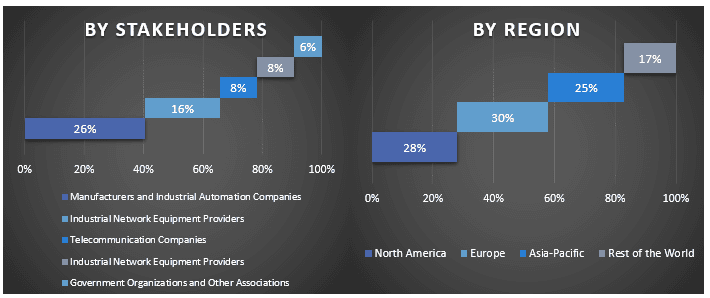
Ingénierie du marché
La technique de triangulation des données a été employée pour compléter l'estimation globale du marché et pour obtenir des chiffres statistiques précis pour chaque segment et sous-segment du marché mondial de la communication industrielle. Les données ont été divisées en plusieurs segments et sous-segments après l'étude de divers paramètres et tendances dans les composants, le protocole de communication, le secteur vertical et les régions du marché mondial de la communication industrielle.
L'objectif principal de l'étude du marché mondial de la communication industrielle
Les tendances actuelles et futures du marché mondial de la communication industrielle ont été identifiées dans l'étude. Les investisseurs peuvent acquérir des informations stratégiques pour baser leur pouvoir discrétionnaire d'investissement sur l'analyse qualitative et quantitative effectuée dans l'étude. Les tendances actuelles et futures du marché ont déterminé l'attrait global du marché au niveau régional, offrant aux acteurs industriels une plateforme pour exploiter le marché inexploité et bénéficier d'un avantage de pionnier. Les autres objectifs quantitatifs des études comprennent :
- Analyser la taille actuelle et prévue du marché de la communication industrielle en termes de valeur (USD). De même, analyser la taille actuelle et prévue des différents segments et sous-segments.
- Les segments de l'étude incluent les domaines des composants, du protocole de communication, du secteur vertical et des régions.
- Définir et analyser le cadre réglementaire pour la communication industrielle
- Analyser la chaîne de valeur impliquée avec la présence de divers intermédiaires, ainsi qu'analyser les comportements des clients et des concurrents de l'industrie.
- Analyser la taille actuelle et prévue du marché de la communication industrielle pour la région principale.
- Les principaux pays des régions étudiées dans le rapport comprennent l'Asie-Pacifique, l'Europe, l'Amérique du Nord et le Reste du monde.
- Profils d'entreprises du marché de la communication industrielle et stratégies de croissance adoptées par les acteurs du marché pour soutenir la croissance rapide du marché.
- Analyse approfondie de l'industrie au niveau régional
Questions Fréquemment Posées FAQ
Q1 : Quelle est la taille actuelle et le potentiel de croissance du marché de la communication industrielle ?
Q2 : Quels sont les facteurs moteurs de la croissance du marché de la communication industrielle ?
Q3 : Quel segment détient la plus grande part du marché de la communication industrielle par protocole de communication ?
Q4 : Quelles sont les principales tendances du marché de la communication industrielle ?
Q5 : Quelle région dominera le marché de la communication industrielle ?
Connexes Rapports
Les clients qui ont acheté cet article ont également acheté

